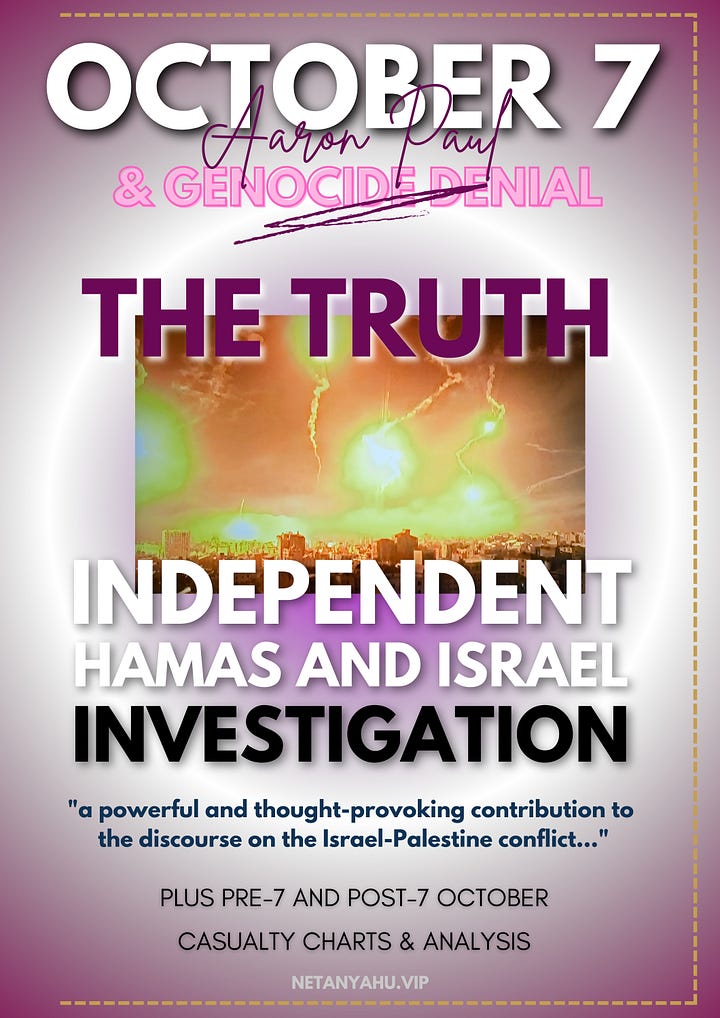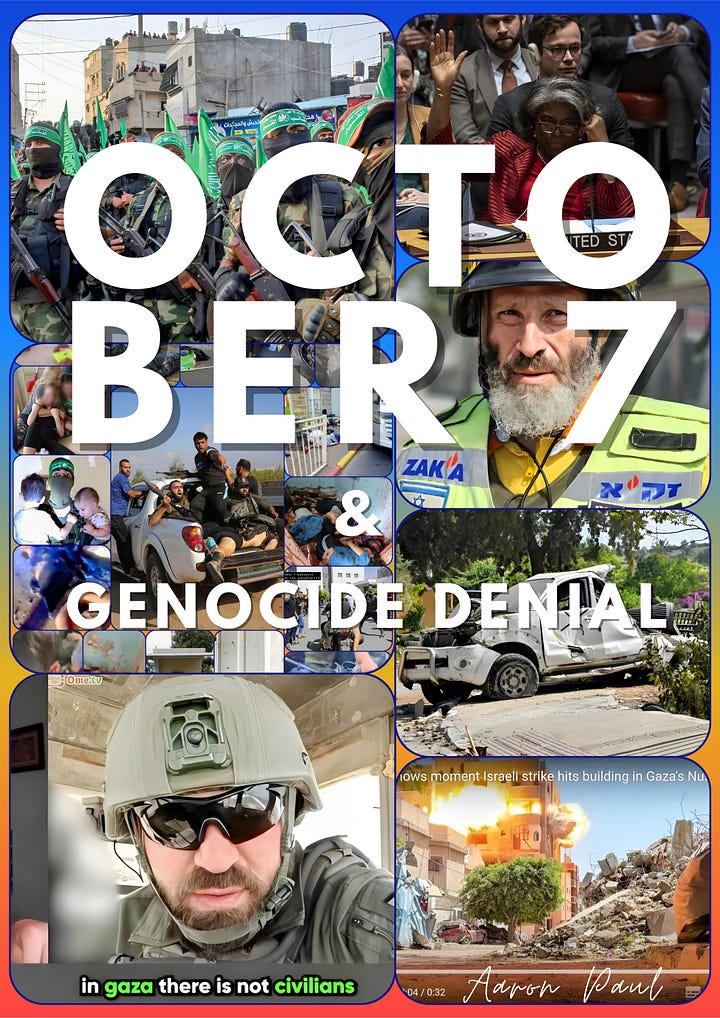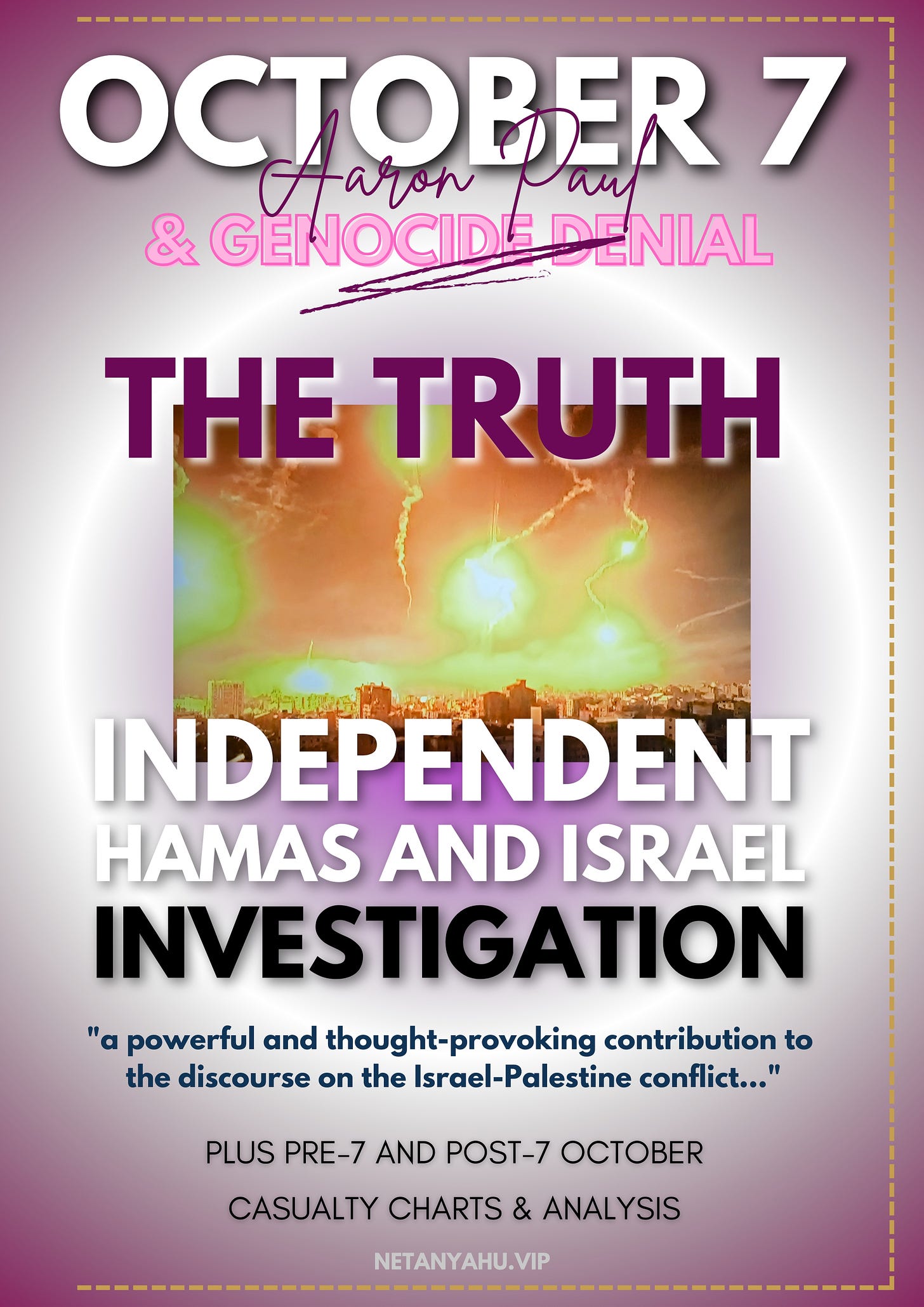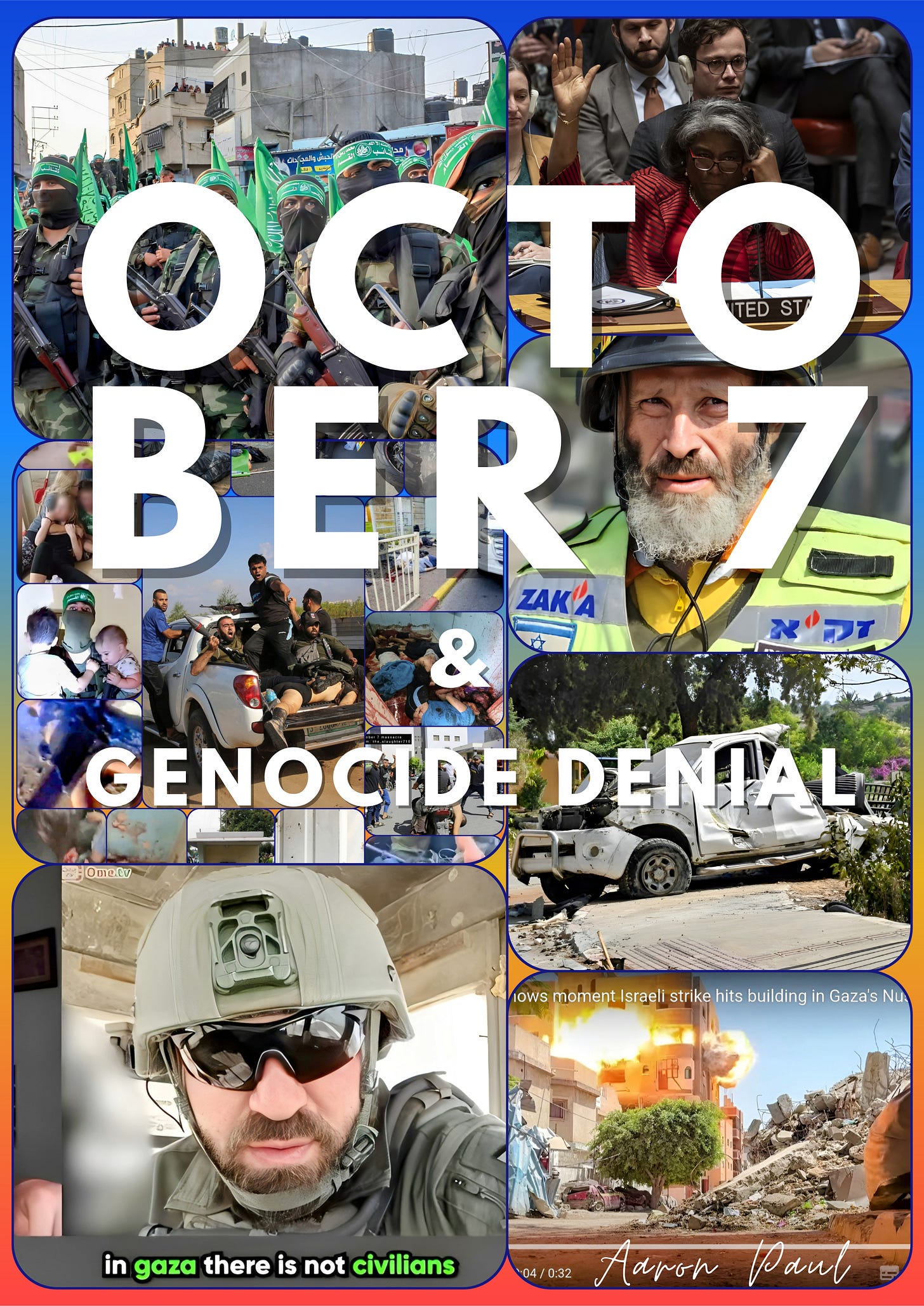TWO DAYS ONLY!!! Sneak Full Preview of previous draft of OCTOBER 7 & GENOCIDE DENIAL - THE TRUTH!
TWO DAYS ONLY!!! Sneak Full Preview of previous draft of OCTOBER 7 & GENOCIDE DENIAL - THE TRUTH!
TOC, indexing, page numbering, and all background artwork for some section text pages are a work-in-urgent-progress!
Constructive 🏗️ feedback very welcome, or feel free be a ZIOnist and take the piss, if you wish!


Deep Seek AI Summary of BOOK DRAFT
The book titled **"October 7 & Genocide Denial - The Truth"** is a comprehensive and critical investigation into the events surrounding the October 7, 2023, attacks in the context of the Israel-Palestine conflict. Written by Aaron Paul, the book challenges mainstream narratives, particularly those propagated by Israel, and provides a detailed analysis of the humanitarian and political dimensions of the conflict. Below are the key points:
### 1. **Purpose and Context of the Book**
- The book aims to provide an independent, illustrated investigative account of what happened on October 7, 2023, and refute claims of genocide denial.
- It is dedicated to the victims of the conflict, including civilians, health workers, journalists, and animals killed in Gaza, the West Bank, Lebanon, Syria, Yemen, and Iran.
- The author, Aaron Paul, transitions from a Christian Zionist to an anti-Israel and anti-Zionist stance after the events of October 7.
### 2. **Key Themes and Arguments**
- **Genocide Denial**: The book explores the definition of genocide and the ways it is denied, particularly in the context of Israel's actions in Gaza and the West Bank.
- **Anti-Semitism**: It distinguishes between true anti-Semitism and criticism of Israel, arguing that conflating the two is a tactic used to silence dissent.
- **Hamas**: The book provides a nuanced view of Hamas, describing it as a resistance group rather than a terrorist organization, and critiques Israel's portrayal of Hamas.
- **October 7 Events**: The book challenges Israel's narrative of the October 7 attacks, refuting claims of widespread atrocities by Hamas, such as the beheading of babies and mass rape. It argues that many civilian casualties were caused by Israel's own military actions, including the implementation of the **Hannibal Directive**, which led to the killing of Israeli civilians and soldiers to prevent their capture by Hamas.
### 3. **Key Claims and Refutations**
- **Beheaded Babies**: The book refutes the widely circulated claim that Hamas beheaded 40 babies, stating that only two babies died on October 7—one from a stray Israeli bullet and the other from a miscarriage.
- **Mass Rape Allegations**: The author argues that there is no credible evidence to support claims of mass rape or sexual violence by Hamas. The allegations are attributed to unreliable testimonies from Israeli first responders and a lack of forensic evidence.
- **Hannibal Directive**: The book claims that Israel's military used the Hannibal Directive, which involves killing Israeli hostages to prevent their capture by enemy forces. This directive allegedly led to the deaths of many Israeli civilians and soldiers on October 7.
- **Israeli Military Failures**: The book highlights the failure of Israeli intelligence and military to prevent the October 7 attacks, despite prior warnings from female spotters and other intelligence sources.
### 4. **Statistical Analysis**
- The book provides detailed statistics on casualties, arguing that the majority of deaths in Gaza and the West Bank were Palestinian civilians, including a high percentage of children and women.
- It compares the death toll in Gaza to historical genocides, suggesting that the rate of child deaths in Gaza exceeds that of the Nazi Holocaust.
### 5. **Critique of Israeli Propaganda**
- The book accuses Israel of spreading disinformation and propaganda to justify its military actions in Gaza. It critiques the weaponization of feminism, where false claims of rape and sexual violence by Hamas were used to garner international support for Israel's military campaign.
- It also criticizes the Israeli government for criminalizing the denial of the October 7 events, comparing it to laws against Holocaust denial.
### 6. **Hamas and Resistance**
- The book presents Hamas as a legitimate resistance movement against Israeli occupation, arguing that its military wing is not a terrorist group but a group fighting for Palestinian liberation.
- It includes Hamas's manifestos and statements, emphasizing its goal of liberating Palestine from Israeli occupation.
### 7. **International and Legal Implications**
- The book discusses the role of international organizations, such as the United Nations and the International Criminal Court, in addressing Israel's actions in Gaza.
- It criticizes the United States and other Western countries for their support of Israel, arguing that this support enables Israel's military actions and human rights abuses.
### 8. **Conclusion**
- The book concludes by calling for a reevaluation of the mainstream narrative surrounding the Israel-Palestine conflict. It advocates for a focus on the humanitarian impact of the conflict and the need for justice and peace in the region.
- The author emphasizes the importance of challenging propaganda and misinformation, particularly in the context of genocide denial and the weaponization of narratives to justify violence.
### 9. **Controversial Claims**
- The book makes several controversial claims, including that Israel knowingly allowed the October 7 attacks to occur to justify a large-scale military response in Gaza.
- It also suggests that Israel's actions in Gaza constitute a second Holocaust, drawing parallels between the Nazi genocide and the current conflict.
### 10. **Author's Perspective**
- Aaron Paul, the author, describes his personal journey from being a Christian Zionist to becoming an anti-Zionist, influenced by the events of October 7 and the subsequent Israeli military campaign in Gaza.
- He expresses deep sympathy for the Palestinian cause and criticizes the international community for its failure to hold Israel accountable for its actions.
### Summary:
The book is a provocative and critical examination of the Israel-Palestine conflict, particularly focusing on the events of October 7, 2023. It challenges mainstream narratives, refutes Israeli claims of atrocities by Hamas, and accuses Israel of committing genocide in Gaza. The author calls for a more nuanced understanding of the conflict, emphasizing the need for justice, accountability, and a reevaluation of the role of international actors in perpetuating the violence.
—
The chapters on **October 7** and the **Hannibal Directive** in the document provide a detailed and critical analysis of the events surrounding the Hamas-led attack on Israel on October 7, 2023, and the subsequent Israeli military response. Here are the key points:
### **October 7 Chapter:**
1. **Context of the Attack:**
- The attack by Hamas on southern Israel did not occur in a vacuum. It was preceded by decades of human rights abuses, displacement, and violence against Palestinians in Gaza and the West Bank.
- The attack resulted in significant casualties, including Israeli civilians, soldiers, and Hamas fighters. However, the author argues that Israel's response was disproportionate and that many Israeli casualties were caused by the Israeli military itself under the **Hannibal Directive**.
2. **Casualty Figures:**
- The official Israeli death toll from October 7 was initially reported as 1,400 but was later revised to 1,139, with 695 civilians, 444 armed personnel, and 71 foreigners.
- The author disputes these figures, claiming that many Israeli civilians were killed by Israeli forces, not Hamas. He estimates that Hamas killed between 345 and 445 civilians, while Israeli forces killed between 250 and 350 civilians under the Hannibal Directive.
3. **Allegations of Atrocities:**
- The author refutes many of the allegations made by Israel against Hamas, including claims of beheaded babies, mass rape, and other atrocities. He argues that these claims were exaggerated or fabricated to justify Israel's military response.
- The author provides evidence, including forensic analysis and testimonies, to debunk claims of widespread sexual violence, beheadings, and other atrocities attributed to Hamas.
4. **Hamas' Role:**
- The author acknowledges that Hamas committed acts of violence, including the killing of civilians and taking hostages, but argues that these actions must be understood in the context of Israel's occupation and oppression of Palestinians.
- He emphasizes that Hamas is a resistance movement fighting against occupation, not a terrorist organization, and that its actions on October 7 were not as extreme as Israel has claimed.
5. **Media and Propaganda:**
- The author criticizes the Israeli government and media for spreading misinformation and propaganda about the October 7 attacks, including false claims of atrocities. He argues that this was done to demonize Hamas and justify Israel's subsequent military actions in Gaza.
---
### **Hannibal Directive Chapter:**
1. **What is the Hannibal Directive?**
- The Hannibal Directive is a controversial Israeli military policy that allows the use of overwhelming force, including lethal measures, to prevent the capture of Israeli soldiers by enemy forces, even if it results in the death of the soldiers.
- The directive was officially canceled in 2016 but was allegedly reactivated during the October 7 attacks.
2. **Application on October 7:**
- The author presents evidence, including testimonies from Israeli military personnel, that the Hannibal Directive was invoked during the October 7 attacks. Israeli forces were ordered to stop Hamas fighters from taking hostages back to Gaza "at any cost," even if it meant killing Israeli civilians and soldiers.
- The author argues that many Israeli casualties on October 7 were caused by Israeli airstrikes and gunfire, not Hamas. He cites reports of Israeli helicopters and drones firing on vehicles and houses, including those containing Israeli hostages.
3. **Chaos and Lack of Command:**
- The Israeli military response on October 7 was chaotic, with a breakdown in command and control. Helicopter pilots and drone operators relied on civilians and local militias for targeting information, leading to indiscriminate fire.
- The author highlights testimonies from Israeli soldiers and officers who admitted to firing on Israeli civilians and hostages, believing they were preventing their capture by Hamas.
4. **Ethical and Legal Concerns:**
- The use of the Hannibal Directive raises serious ethical and legal questions, particularly regarding the intentional killing of Israeli captives to prevent their abduction. The author argues that this practice violates international humanitarian law.
- The directive's alleged use on October 7 has fueled public anger in Israel, with many questioning the government and military's handling of the crisis.
5. **Historical Context:**
- The Hannibal Directive has a controversial history, with previous instances of its use leading to significant civilian casualties. For example, during the 2014 Gaza war, the directive was linked to the deaths of up to 200 Palestinian civilians, including 75 children, in Rafah.
---
### **Conclusion:**
- The author argues that the events of October 7 and the subsequent Israeli military response, including the alleged use of the Hannibal Directive, highlight the brutality and moral failings of both Hamas and the Israeli government.







I applaud your dedication to the Palestinians.
Interesting to see the preview. You have worked hard with a lot of detail but not all of it accurate.
The map showing Philistia is a fabrication. There is no historical or archaeological evidence for a kingdom of Israel so to present it as existing is wrong. This is a religious story with no factual substance. This is a religious map, not a historical map and I suspect it is recent in construction.
Even Uri Avnery said that in 2018 before he died. And since the tribe of Judah was from what is now called Iraq, they were colonists then as now. And THERE WAS NO EXODUS so you should specify that the map is not historical or factual but a recreation based on religious belief.
Avnery said:
“The Egyptians were obsessive chroniclers. Many tens of thousands of tablets have already been deciphered. It would have been impossible for an event like the exodus to pass without being reported at length. Not if 600,000 people left, as the Bible tells it, or 60,000, or even 6000. Especially if during the flight a whole Egyptian army contingent, including war chariots, was drowned.
The same goes for the Conquest. Because of acute security concerns, after being invaded once from there, the Egyptians employed a host of spies, - travelers, merchants and others - to follow closely the events in neighboring Canaan, in every single one of its towns and at all times. An invasion of Canaan, even a minor one, would have been reported. Except for the periodic incursions of Bedouin tribes, nothing was recorded."
Moreover, the Egyptian towns mentioned in the Bible did not exist at the time the event is supposed to have happened. They did exist, however, when the Bible was written, in the first or second century BC.
There is no need to point out that in a hundred years of frantic archaeological searching by devout Christians and Zionist zealots, not a shred of concrete evidence for the conquest of Canaan has been found (nor that the Kingdoms of Saul, David or Solomon ever existed. “